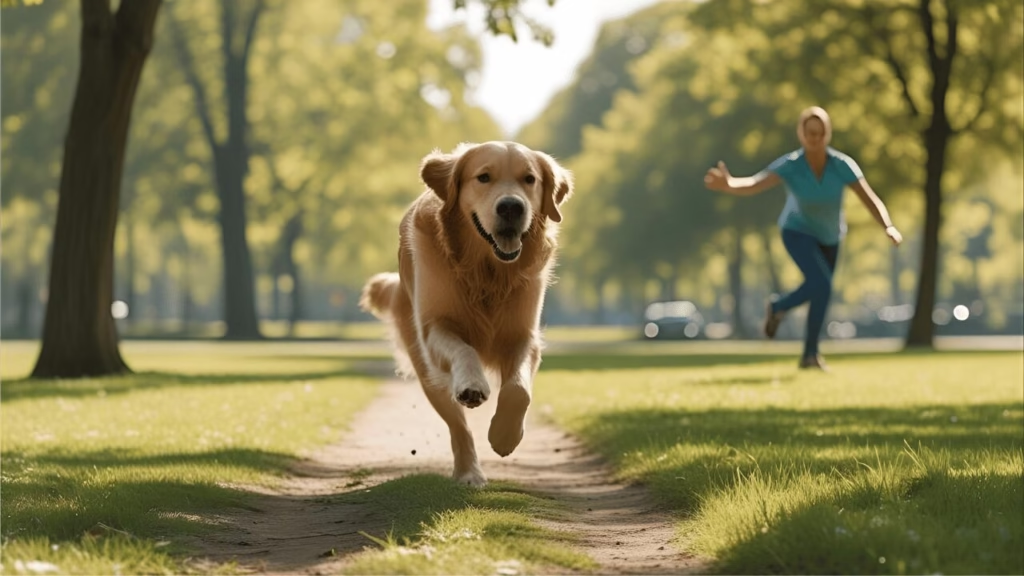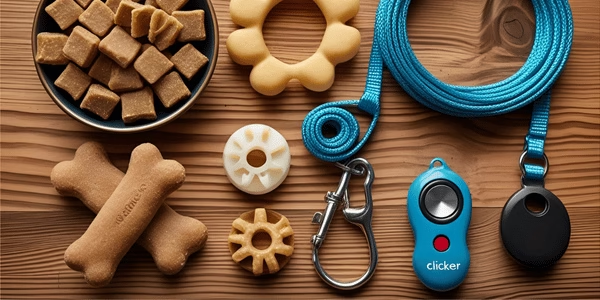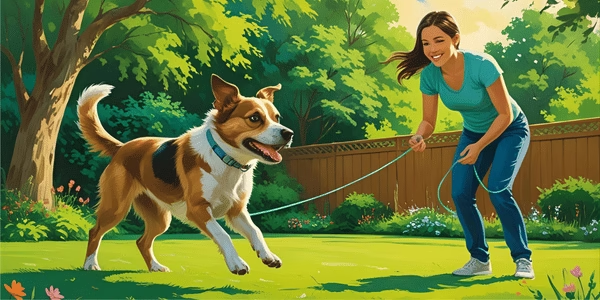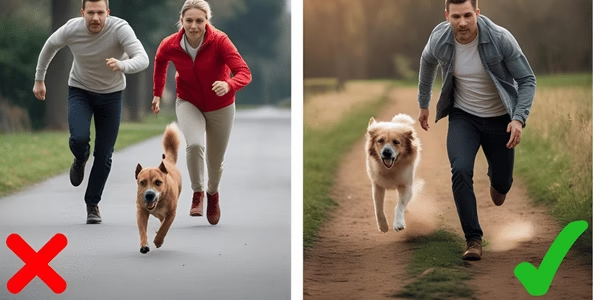Let’s get real for a second.
If you’re reading this, you’re probably standing in a dog park right now, screaming “COME!” at your dog while they pretend you don’t exist.
Or maybe you’re the person frantically chasing your dog around the neighborhood because they slipped out the front door and discovered that freedom tastes better than your recall training ever did.
Sound familiar?
Here’s the thing most dog owners don’t realize: teaching your dog to come when called isn’t actually that hard.
The problem? You’ve accidentally taught your dog that “come” means “fun’s over.”
But don’t worry. We’re about to fix that.
This guide walks you through the exact system professional trainers use to build bulletproof recall, the kind where your dog drops everything and races back to you like you just opened a bag of treats (because, well, you probably did).
Why Your Dog Ignores You (And It’s Not Because They’re Stubborn)
Before we dive into solutions, let’s talk about why your dog gives you the cold shoulder when you call.
Reason #1: You’ve accidentally poisoned the cue
Think about it. When do you usually call your dog?
- When it’s time to leave the dog park
- When you need to give them a bath
- When you’re about to clip their nails
- When playtime is over
No wonder they’ve learned that “come” equals disappointment.
Your dog isn’t being defiant. They’re being logical.
Reason #2: They don’t actually know what “come” means
A lot of dogs think “come” is just background noise,like when you say “good morning” to your coffee maker.
They’ve never been properly taught that it’s a specific request that requires action.
Reason #3: The payoff isn’t worth it
If coming to you means a quick pat on the head while that squirrel over there promises endless entertainment, guess who wins?
Your dog isn’t stubborn. They’re just doing the math.
Pro tip: If your dog has been ignoring “come” for months, it might be time to start fresh with a brand-new recall word. Your current cue might be totally burned.
The Foundation: What You Need Before You Start
Pick Your Recall Word (And Stick With It)
Choose one word. Could be “come,” “here,” or honestly, “banana” if you want to.
The word doesn’t matter. Consistency does.
And if you’ve been using “come” with zero success for the past six months? Pick a new word. Start fresh.
Your Secret Weapons
Here’s what you’ll need:
- High-value treats: We’re talking tiny pieces of chicken, cheese, hot dogs, whatever makes your dog lose their mind
- A 20-30 foot long line: For outdoor training (not a retractable leash, those are garbage for training)
- Patience: This isn’t a weekend project
- A helper: Optional but useful for advanced training
Related: Need help with other foundational skills? Check out our Complete Dog Obedience Training Guide.
The 4-Stage Training System (That Actually Works)
Stage 1: Build the Foundation (Week 1-2)
Start in your living room. Not the dog park. Not your backyard. Your boring, distraction-free living room.
The Basic Exercise:
- Show your dog a treat
- Take a step backward
- Say your recall word once
- When they move toward you, praise like they just won the lottery
- Reward immediately when they reach you
Critical mistake to avoid: Don’t repeat the command. Say it once, then wait. If they don’t respond, make yourself more interesting, clap, make weird noises, or run backward. But don’t say “come, come, COME!” You’re just teaching them they can ignore you the first few times.
Practice this 5-10 times per day in short sessions. Your dog should start perking up and moving toward you the moment they hear the word.
Stage 2: Add Distance and Rooms (Week 2-3)
Once your dog is reliably responding in the same room, it’s time to level up.
The Hide-and-Seek Method:
- Go to another room
- Call your dog using your recall word
- When they find you, throw an absolute party, treats, praise, maybe even a little victory dance
- Gradually increase the distance within your home
This teaches your dog that coming to you is worth the effort, even when they can’t see you.
Stage 3: Introduce Controlled Distractions (Week 3-4)
Now we’re getting to the real world. Move to your backyard or another enclosed space.
The Long Line Technique:
- Attach a 20-30 foot long line to your dog’s harness (never the collar, you could hurt their neck)
- Let them explore and get mildly distracted
- Call them using your recall word
- If they come immediately, jackpot reward them with multiple treats
- If they ignore you, gently guide them with the line (don’t drag them)
The golden rule: Never call your dog if you can’t enforce it. Every ignored command teaches them that listening is optional.
Stage 4: Real-World Proofing (Week 4+)
This is where most people rush and ruin months of progress.
Don’t be that person.
Gradually increase distractions:
- Other dogs playing nearby
- Interesting smells
- People walking by
- Squirrels (the ultimate boss-level challenge)
Keep that long line attached until your dog has a 100% success rate in each environment.
And yes, that means you might be using a long line for months. That’s normal.
Struggling with squirrel distractions? We have an entire guide on that: How to Train Your Dog to Ignore Squirrels.
Step-by-Step Training Schedule (The Realistic Timeline)
Here’s what your training schedule should actually look like if you want results:
| Week | Focus | Environment | Success Metric |
|---|---|---|---|
| 1-2 | Foundation work | Inside home, zero distractions | Dog comes 90%+ of the time indoors |
| 2-3 | Distance & hide-and-seek | Different rooms, mild distractions | Dog comes from other rooms reliably |
| 3-4 | Outdoor introduction | Fenced yard with long line | Dog responds with light outdoor distractions |
| 4-6 | Moderate distractions | Quiet parks, low-traffic areas | Dog comes when mildly distracted outdoors |
| 6-8 | Advanced distractions | Busy parks, other dogs present | Dog comes even with moderate distractions |
| 8-12 | Reliability testing | High-distraction environments | Dog comes reliably in real-world situations |
| 12+ | Maintenance & off-leash prep | Varied environments | Consistent recall, begin off-leash work |
Note: Every dog progresses at their own pace. Some dogs will move faster, others slower. Don’t rush it.
Advanced Techniques (Once You’ve Mastered the Basics)
The “Catch Me” Game
While walking your dog on-leash, suddenly turn and run a few steps away while calling their name and recall word.
Most dogs can’t resist chasing you, which makes recall feel like play rather than work.
The Two-Person Recall
Have a family member hold your dog while you walk away. Call them, and when they come racing over, reward heavily.
Take turns being the caller, this teaches your dog that coming to any family member is rewarding.
The Emergency Recall
Train a separate, super-charged recall for genuine emergencies.
Use a whistle or unique word, and only use it for life-or-death situations.
When you use it, give your dog the best reward they’ve ever received, an entire chicken breast, their favorite toy, whatever it takes.
This is your “break glass in case of emergency” recall.
Common Mistakes That Sabotage Your Progress
Let’s talk about the stuff that’s killing your recall training.
Mistake #1: Calling Your Dog to End Fun Activities
What you’re doing: Calling your dog when it’s time to leave the dog park, come inside, or stop playing.
What your dog learns: “Come” = fun’s over.
The fix: Call them multiple times during play, reward them, then release them back to what they were doing. This teaches them that coming to you doesn’t always mean the party’s over.
Mistake #2: Using Recall for Punishment
What you’re doing: Calling your dog over to scold them, give them medicine, or do anything they dislike.
What your dog learns: Coming to you = bad things happen.
The fix: Never, ever call your dog for something unpleasant. Go get them instead.
Mistake #3: Repeating the Command
What you’re doing: “Come. Come. COME. COME HERE RIGHT NOW!”
What your dog learns: They can ignore you the first few times.
The fix: One clear command, then wait. Make yourself more interesting if needed, but don’t repeat the word.
Mistake #4: Chasing Your Dog
What you’re doing: Running toward your dog when they don’t come.
What your dog learns: Tag! You’re it!
The fix: Run away from them or make yourself more interesting where you are. Never chase.
Mistake #5: Inconsistent Training
What you’re doing: Training hard for a week, then nothing for two weeks, then back to training.
What your dog learns: Confusion.
The fix: Short, daily sessions beat marathon weekend sessions every time.
Mistake #6: Moving Too Fast to High Distractions
What you’re doing: Your dog can barely recall in your backyard, but you’re testing them at the dog park.
What your dog learns: Ignoring you works fine in exciting places.
The fix: Slow down. Master each environment before moving to the next.
Emergency Recall Protocols: When Things Go Wrong
Let’s talk about emergency situations, because they will happen.
Scenario 1: Your Dog Slips Out the Door
What NOT to do: Chase them, scream, or panic.
What TO do:
- Stay calm (I know, easier said than done)
- Use your emergency recall if you’ve trained one
- If they don’t respond, try running away from them
- Get in your car and open the door, many dogs will jump in for a car ride
- Use high-value treats and your happiest voice
Scenario 2: Your Dog is Running Toward Danger
What NOT to do: Scream in a panicked voice (they’ll think it’s a game).
What TO do:
- Use your emergency recall command
- If trained, use a recall whistle (carries farther than your voice)
- Drop to the ground, most dogs will come investigate
- Run the opposite direction, triggers their chase instinct
Scenario 3: Your Dog Won’t Let You Grab Their Collar
The problem: They come close but stay just out of reach.
The solution: Practice the “collar grab game” at home:
- Touch their collar
- Immediately reward
- Gradually work up to holding the collar for longer
- Eventually, grab collar, reward, release back to play
Prevention is key: Train an emergency “drop” or “down” command as a backup. If your dog won’t come, you can at least get them to stop moving.
Using Positive Reinforcement (The Only Method That Actually Works)
Let’s talk about why positive reinforcement is the only training method worth using.
Punishment-based methods (prong collars, leash corrections, yelling) might stop a behavior temporarily, but they don’t address the root cause.
And they usually make things worse.
Why positive reinforcement works:
- Builds trust instead of fear
- Replaces fear with positive associations
- Helps dogs make better choices on their own
- Creates long-term behavior change
- Increases confidence in both dog and owner
The concept is simple: reward what you want to see more of.
Your dog comes when called? Party time. Treats, praise, play, whatever they love.
Your dog ignores you? No punishment. Just go back a step in training.
Troubleshooting: When Things Don’t Go as Planned
Problem: My Dog Comes But Won’t Let Me Grab Their Collar
Solution: You’re reaching for them too quickly. Let them come all the way to you before moving. Better yet, teach them to sit when they reach you.
Problem: Perfect at Home, Terrible Outside
Solution: You moved too fast. Go back to easier environments and build up more slowly. Use higher-value rewards outdoors.
Problem: Only Comes When They Feel Like It
Solution: This is called “selective hearing.” Go back to basics with a long line. Never call them unless you can enforce it. Make coming to you the best thing in their world.
Problem: Comes to Other Family Members But Not Me
Solution: You’ve probably poisoned the cue for yourself. Either start fresh with a new recall word, or have other family members do all the recall training with you for a few weeks.
FAQ: Your Burning Questions Answered
Q: How long does it take to train a dog to come when called?
A: Most dogs show significant improvement within 2-4 weeks of consistent training. Building bulletproof recall, the kind where your dog comes even with major distractions, usually takes 3-6 months. Every dog is different, so your timeline might vary.
Q: Can you teach an old dog reliable recall?
A: Absolutely. While puppies might learn faster, adult dogs can definitely master recall. The key is patience and consistency, regardless of age. I’ve seen 10-year-old dogs learn perfect recall.
Q: What if my dog has selective hearing and only comes when they feel like it?
A: This means they’ve learned the command is optional. Go back to basics with a long line, never call them unless you can enforce it, and make coming to you incredibly rewarding. You need to rebuild the behavior from scratch.
Q: Should I use an e-collar for recall training?
A: E-collars can work when used properly by experienced trainers, but they’re not necessary for most dogs. Focus on positive reinforcement first, it’s safer and builds a better relationship. Most recall problems are caused by training mistakes, not a need for punishment tools.
Q: My dog comes when called at home but ignores me at the dog park. What’s wrong?
A: The dog park is like Times Square for dogs—overwhelming distractions everywhere. You need to practice in gradually more challenging environments before expecting success in high-distraction areas. You skipped steps. Go back and build up slowly.
Q: How long until I see progress?
A: Most owners see noticeable improvements within the first 1-2 weeks of consistent training in low-distraction environments. Real-world reliability takes longer—typically 8-12 weeks minimum. Some dogs with high prey drive or previous bad training might take 4-6 months to achieve reliable recall in all situations.
Q: What treats work best for recall training?
A: Use whatever makes your dog lose their mind. Popular options: tiny pieces of chicken, string cheese, hot dogs, freeze-dried liver, or commercial high-value treats. The key is that the treat needs to be more exciting than whatever’s distracting them.
Q: Can I ever let my dog off-leash?
A: Only when they have 100% reliable recall in that specific environment with those specific distractions. Start in enclosed areas and build up gradually. Some dogs with extremely high prey drive may never be safe off-leash around wildlife, and that’s okay. Safety first.
Your Next Steps
Teaching your dog to come when called isn’t just about obedience, it’s about freedom.
A dog with reliable recall can enjoy off-leash hikes, beach runs, and the kind of adventures that make both of you happier.
Start with Stage 1 today.
Grab some treats, find a quiet room, and practice for just 5 minutes.
Your future self (and your dog) will thank you when you’re confidently exploring the world together, connected by trust instead of a leash.
Every professional dog trainer started exactly where you are now.
The difference between success and frustration isn’t talent, it’s consistency and patience.
What are you waiting for?
Your dog is ready to learn. Are you ready to teach them?
Want more training help? Check out our complete guides:
Resources:








